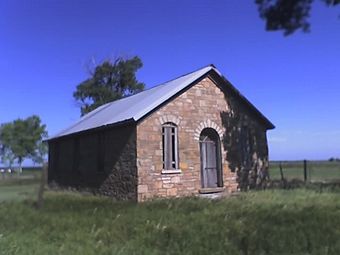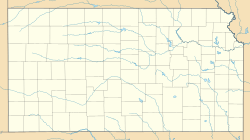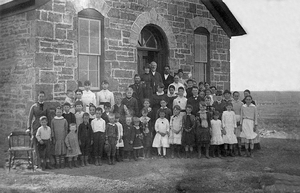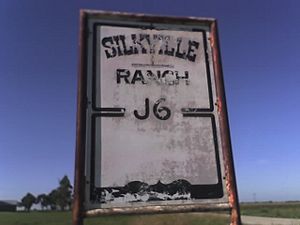Silkville, Kansas facts for kids
Quick facts for kids |
|
|
Silkville
|
|

Silkville's school house
|
|
| Location | Williamsburg Township, Franklin County, Kansas |
|---|---|
| Nearest city | Williamsburg, Kansas |
| Area | 6 acres (2.4 ha) |
| Built | 1870 |
| NRHP reference No. | 72000504 |
| Added to NRHP | December 15, 1972 |
Silkville is a ghost town in Franklin County, Kansas, United States. A ghost town is a place where people used to live, but now it's mostly empty. Silkville was located near Williamsburg, Kansas.
This unique settlement was started in the late 1800s by a French man named Ernest de Boissière. He believed in a special idea called utopian socialism. This idea was about creating a perfect community where everyone worked together. Silkville was all about making silk. People were paid based on how much silk they produced. Silkville's silk was even praised at a big event in Philadelphia in 1876. But over time, people left, and it was hard to sell the silk. This caused the community to fail. Today, only a few old buildings are left.
Contents
The Story of Silkville
Silkville was founded in 1870 by Ernest de Boissière. He was born in France in 1810 to a very old and important family. Boissière had strong ideas about how society should work. He was inspired by a philosophy called utopian socialism, which aimed to create ideal communities.
Because of his different political views, Boissière faced danger from the ruler of France at the time, Napoleon III. In 1851, Napoleon III became emperor. Boissière was forced to leave France and moved to America. He first settled in New Orleans. There, he started a shipping business. However, he used some of his money to help orphaned Black children. This made some wealthy white people in New Orleans upset. To escape their disapproval, Boissière decided to leave the American South.
He then chose to move to Franklin County, Kansas. He thought this area would be perfect for building his ideal community. In 1869, Boissière bought a large amount of land, about 3,000 to 3,500 acres. He then began to set up his special settlement.
Building a Silk Community
After being called by a few different names, Boissière's colony became known as Silkville. This name fit perfectly because the main goal was to make silk. The very first building Boissière built was a huge house. People in the area called it the "Chateau." For a while, it was the biggest house in Kansas. It had sixty rooms and could hold 50 to 100 people! The house also had a giant library with 2,500 books.
Boissière also built a stone building for silkworms, called a cocoonery. He planted thousands of mulberry trees to feed the silkworms. Later, he added hundreds of peach, apple, and ailanthus trees, plus over a thousand grapevines. To teach the children in the colony, Boissière started a school. A historian named Daniel Fitzgerald said it was the first school in Kansas to teach about world literature.
How Silkville Worked and Why It Failed
Boissière set up his community so that people were paid based on how much they produced. This meant hard workers who made a lot of silk earned more. When it first started, 40 French people moved to the colony. Each person paid $100 to join.
In 1875, Charles Sears, a friend of Boissière's, moved to Silkville. His arrival really helped the silk production. The next year, Silkville's silk was highly praised at the Centennial Exposition in Philadelphia. This was a big fair to celebrate 100 years of the United States.
Even with this success, Silkville struggled to make money. One reason was that it had to compete with cheaper fabrics from Asia. Also, Boissière refused to use less expensive American dyes. Over the years, many members left the community. Most of them had only spoken French when they arrived. But they learned English and started to fit into regular American society. Many also realized that for the $100 they paid to join, they could have bought their own land.
To try and keep the community going, Boissière changed what they produced. They started making butter and cheese, and raising farm animals. This helped Silkville survive for a few more years. But eventually, the community fell apart, and its members moved away.
Boissière returned to France in 1892 and died two years later. His property was given to a group called the Independent Order of Odd Fellows to use as an orphanage. But they couldn't afford to keep it. After a long legal fight, the property went to lawyers from Topeka. In 1916, a fire badly damaged the "Chateau." Only a part of it was ever rebuilt.
What's Left Today?
Today, not much is left of Silkville. Only three stone buildings remain: the old school house and two barns. The original "Chateau" that Boissière built, which cost $10,000 back then, was destroyed by the fire. A modern house was built over the western part of the ruins, using some of the old stone.
One of the barns you see today used to be the cocoonery, where the silkworms were kept. It became a one-story building after a tornado damaged its top floor. In 1972, these remaining buildings were added to the National Register of Historic Places. This was because they are important to the history of Kansas. Their historical importance comes from being an intentional community and for their practice of sericulture (silk making).
Where Was Silkville?
Silkville is located at an elevation of 1,161 feet (354 meters). Its exact location is 38°27′0″N 95°29′21″W / 38.45000°N 95.48917°W.




